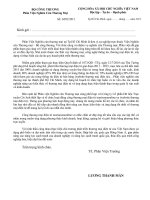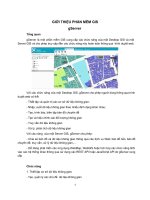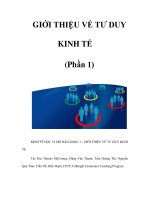Chuong gioi thieu (phan 1) ppt
Bạn đang xem bản rút gọn của tài liệu. Xem và tải ngay bản đầy đủ của tài liệu tại đây (500.03 KB, 33 trang )
Chapter 1
The Environment and Sustainability Science
Environmental Chemistry, 9th Edition
Stanley E. Manahan
Taylor and Francis/CRC Press
2010
1.1 From the Sun to Fossil Fuels and Back Again
Early 2000s have shown evidence of strain on Earth's support systems
Shortages and high prices for fuel and materials in early 2008
• Leading to economic collapse
Evidence of global warming
• Glaciers melting
• Loss of Arctic ice cap
Stress and depletion of Earth's natural capital
• Agricultural land depleted
• Water sources limited
• Wildlife habitat lost
2
2
The Brief But Spectacular Era of Fossil Fuels
• Began with coal in latter 1700s
• Coal-fired steam engine as a source of power
• Progressed to petroleum and natural gas
• Petroleum supplies will become exhausted within decades
• New supplies of natural gas are being found
• Natural gas is an ideal fossil fuel for many applications
• Not all coal can be used because of global warming potential
Relative to the time of human life on Earth, the era of fossil fuels must soon end
• How it ends and what replaces it will largely determine the welfare of humankind for centuries
to come
3
Back to the Sun for Energy, Fuel, and Raw Materials
• Direct use for solar heating and solar voltaic power generation
• Indirect use for wind, biomass, hydroelectric (solar-powered hydrologic cycle)
Photosynthetically-Produced Biomass for Synthetic fuels
• Fermentation of sugars to ethanol
• Chemical conversion of lipids to synthetic diesel fuel
• Chemical conversion of biomass to CO and H
2
followed by chemical synthesis of hydrocarbons
and alcohols
Several abundant sources of biomass
• Crop byproducts such as corn stover
• Dedicated crops such as hybrid poplar or corn stover
• Highly productive algae, which may even be grown in brackish water
4
1.2. The Science of Sustainability
Sustainability or sustainable development is an economic and industrial system that meets the needs of the present
without compromising the ability of future generations to meet their own needs (Bruntland Commission 1987)
• Maintenance of Earth’s ability to maintain an acceptable level of human activity and consumption over a sustained
period of time.
Nobel-level breakthroughs required to achieve sustainability (Chu, 2009)
1. Solar energy capture and conversion to electricity to improve several-fold
2. Improved electric batteries
• Capture and store electricity from intermittent renewable sources
• Practical driving range in electric vehicles
3. Improved crops to convert more solar energy to biomass chemical energy
• Now less than 1%
• Genetic engineering should improve several-fold
5
Environmental Science
The science of the complex interactions that occur among the terrestrial, atmospheric, aquatic,
living, and anthropological systems that compose Earth and the surroundings that may affect
living things
Green Science and Technology
The practice of sustainable science and technology
Green Chemistry
The practice of inherently safer and more environmentally friendly chemical science
Green Engineering
Engineering practiced in a sustainable and environmentally friendly manner
6
7
Environmental chemistry has developed as a positive force for a clean
environment
• Revealing problems such as by pollutant analysis
• Measures to control pollution
• Foreseeing problems before they develop
• Appropriate action to forestall environmental problems
• Support of other disciplines such as industrial ecology and green chemistry
employed in environmental improvement
Toxicological chemistry relates the chemical nature of substances to their
adverse effects on organisms
8
1.4 WATER, AIR, EARTH, LIFE, AND TECHNOLOGY
Much of environmental chemistry deals with the interchange of materials among
water, air, earth, and biological systems and the effects of technology thereon
See Figure 1.2 (next slide)
Biogeochemical cycles describe the interchange of matter and energy among
the various environmental spheres
• Effects of organisms
• Effects of humans (technology)
9
10
Water and the Hydrosphere
• Covers 70% of Earth’s surface
• 97% in oceans
• Most remaining fresh water in ice
Water plays essential roles in all environmental spheres
• Essential to life
• Transfers plant nutrients from soil to roots
• Dissolves minerals and forms deposits in the geosphere
• Transfer of water and energy in the atmosphere
• Many industrial uses and transfer of energy (latent heat in steam) in the
anthrosphere
11
Air and the Atmosphere
• Source of essential gases
• Oxygen for animals and other organisms
• Carbon dioxide for plant photosynthesis
• Nitrogen converted to chemically combined form as a plant nutrient
• Oxygen, nitrogen and argon for industrial uses
• Protective functions
• Filters out damaging ultraviolet radiation
• Regulates Earth’s surface temperature within a range compatible with life
Aspects of Atmospheric Science
• Movement of air masses
• Heat balance
• Chemical properties and reactions
12
Earth: The Geosphere
Solid iron-rich inner core/molten outer core/mantle/crust
Crust is Earth’s thin outer skin (5-40 km thick)
• Interacts with other spheres
• Provides life support, food, minerals, fuels
Geology is the science of the geosphere
• Considers mineral solids
• Interaction with water
• Interaction with atmosphere
• Effects upon and by living organisms
• Engineering geology considers human interactions with and modifications of
the geosphere
13
The Biosphere: Living Organisms
Biology is the science of life
• Deals largely with macromolecules synthesized by organisms
• Ultimate environmental concern is interaction with life
• Toxic substances in the environment affect organisms including humans
• Environmental biodegradation of toxic substances
14
Technology and the Environment
• Ways in which humans do and make things with materials and energy
• How humans construct and operate the anthrosphere
• Product of engineering based on science
Challenge is to integrate technology with considerations of the environment and
ecology
• Properly applied technology can benefit the environment
• Pollution control technology
• Constructed environmental features such as artificial wetlands
• Efficient energy conversion processes
• Renewable energy resource utilization
• Production of goods with minimum waste
• High-speed, minimally polluting transportation systems
15
1.5 ECOLOGY, ECOTOXICOLOGY, AND THE BIOSPHERE
The biosphere is in a thin layer at the interface of the atmosphere with the geosphere and
hydrosphere
Strong mutual interactions between organisms and the other environmental spheres
• Earth’s oxygen produced by organisms
• Atmospheric CO
2
removed by photosynthesis
• Biological processes largely determine aquatic chemistry
• Geospheric rocks weathered by organisms
Sequestering solar energy and carbon as biomass, represented {CH
2
O}, by photosynthesis:
• CO
2
+ H
2
O + h
ν
→ {CH
2
O} + O
2
Biodegradation of biomass by organisms:
• CO
2
+ H
2
O + h
ν
→ {CH
2
O} + O
2
16
Ecology
Deals with the relationships between living organisms with their physical
environment and with each other
Ecosystem
Group of organisms interacting to mutual advantage and with their environment
• Cycles of material in ecosystems
• An organism lives in its habitat in the environment
• The role it plays is its niche
A population consists of the numbers of a particular species in a habitat
17
Ecotoxicology
Toxicology refers to the detrimental effects of poisonous chemical species
(toxicants) on organisms
Ecotoxicology refers to the detrimental effects of toxicants on ecosystems
• At several levels ranging from biological effects to effects upon whole
populations
18
1.6. ENERGY AND CYCLES OF ENERGY
19
Earth receives solar energy at 1,340 watts/meter
2
at the top of the atmosphere
• Enormous amount of incoming energy largely in visible region of the
electromagnetic spectrum
• Must re-radiate this energy to outer space as longer-wavelength infrared
radiation
Light and Electromagnetic Radiation
20
Electromagnetic radiation carries energy through space at 3.00 x 10
8
meters/second (c, speed of light)
In order of shortest wavelength (more energetic) to longer wavelength (less
energetic):
• gamma>X-rays>ultraviolet>visible>infrared
Characteristics of wavelength (λ, meters), amplitude, and frequency (ν, s
-1
or
Hertz)
• νλ = c
Energy: E = hν where h is Planck’s constant
Dual wave/particle nature of electromagnetic radiation
Energy Flow and Photosynthesis in Living Systems
Figure 1.3. Energy conversion and transfer by photosynthesis
21
1.7 HUMAN IMPACT AND POLLUTION
Pollutant: Substance in greater than natural concentration that is detrimental
Contaminants cause deviations from normal concentration but are not pollutants
unless they have adverse effects
22
1.8 CHEMICAL FATE AND TRANSPORT
Interchanges of contaminants released from the anthrosphere among various segments of the other environmental spheres and
illustrations of pathways involved in chemical fate and transport.
23
Fate and transport of contaminants controlled largely by
• Physical transport: Movement without reacting or interacting with other phases
• Reactivity: Including chemical or biochemical reactions or physical interactions
with other phases
24
Three Major Environmental Compartments Considered in Chemical
Fate and Transport
25









